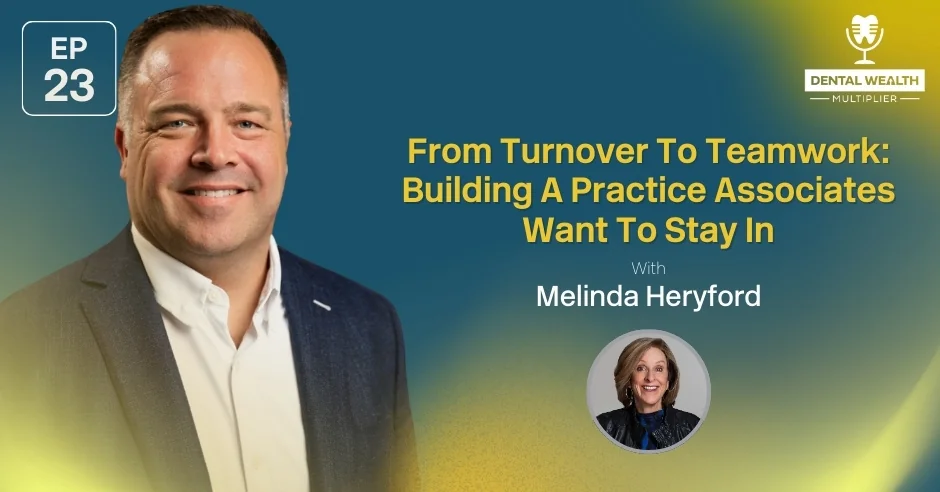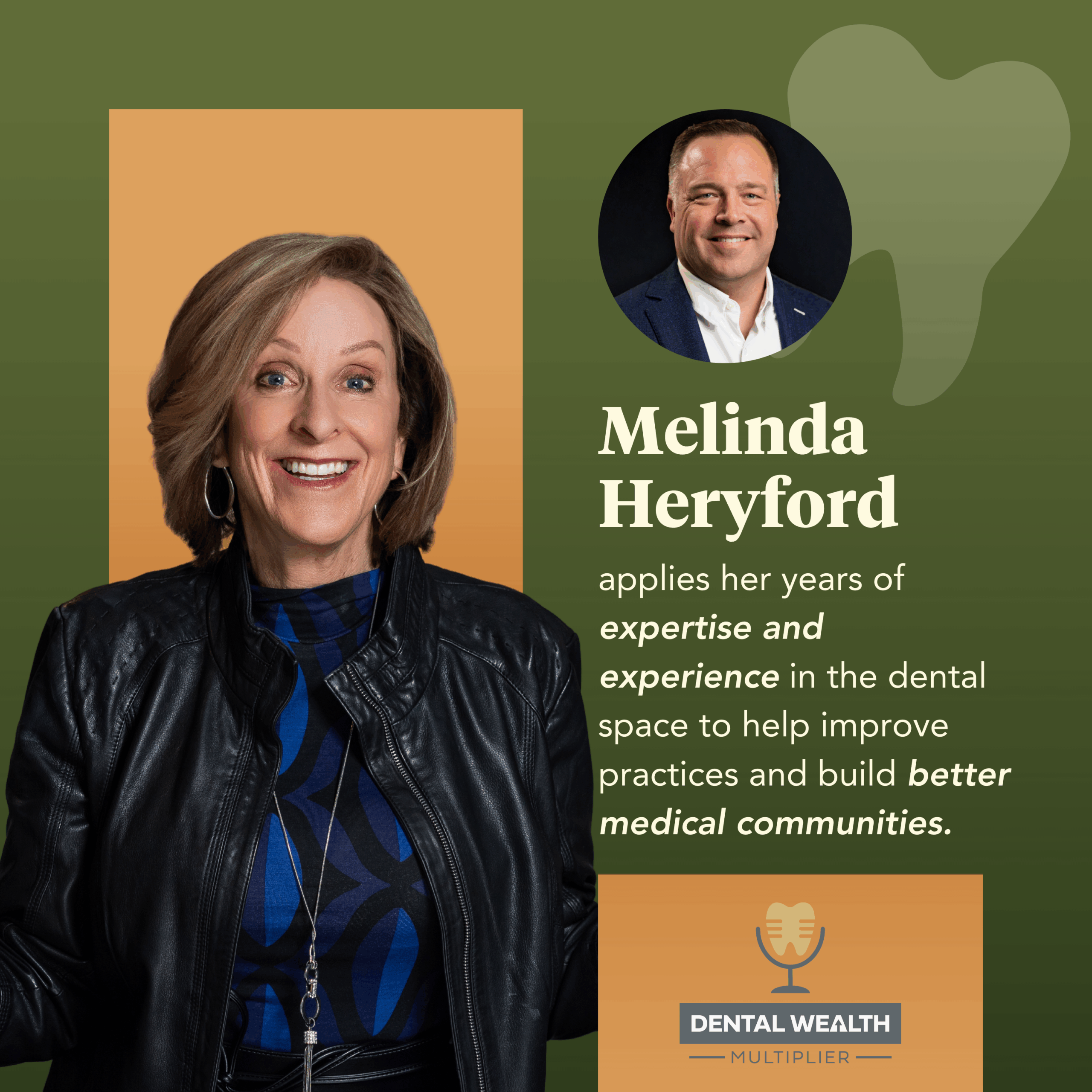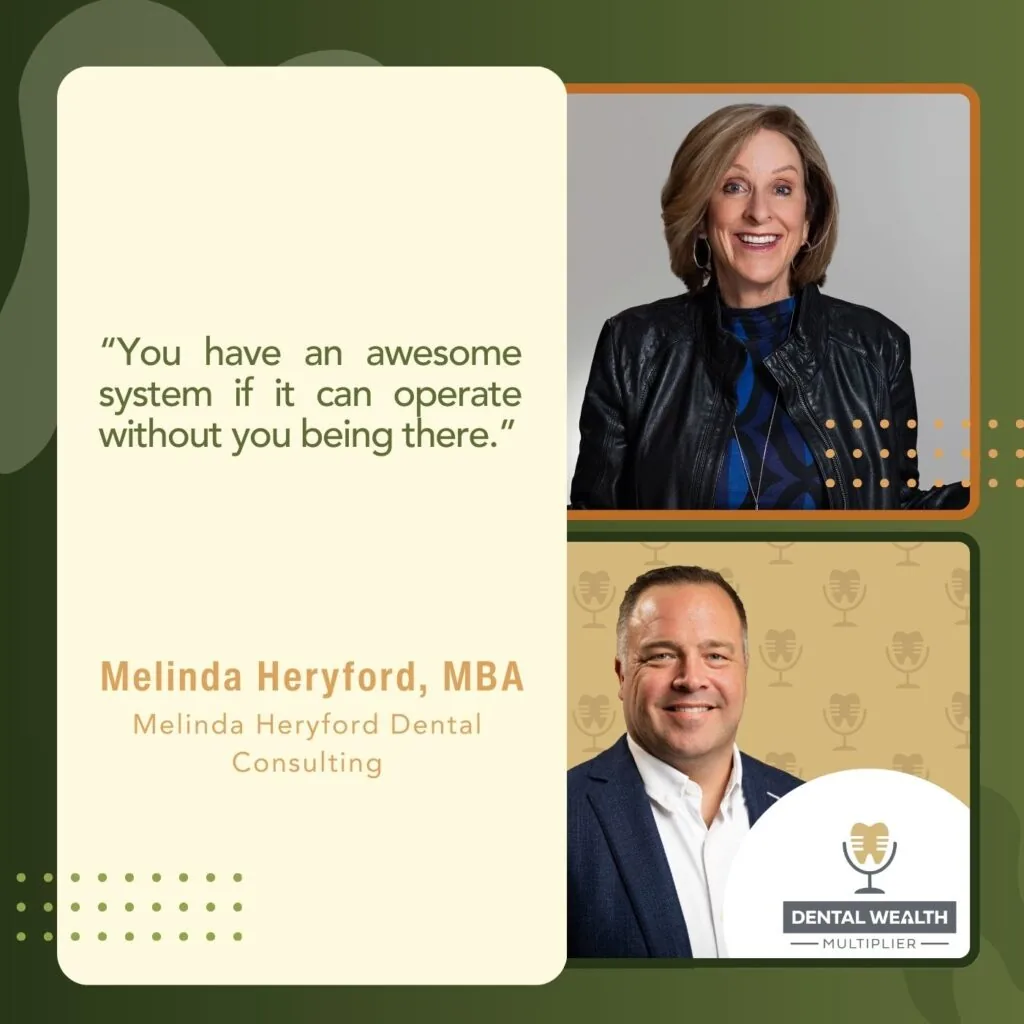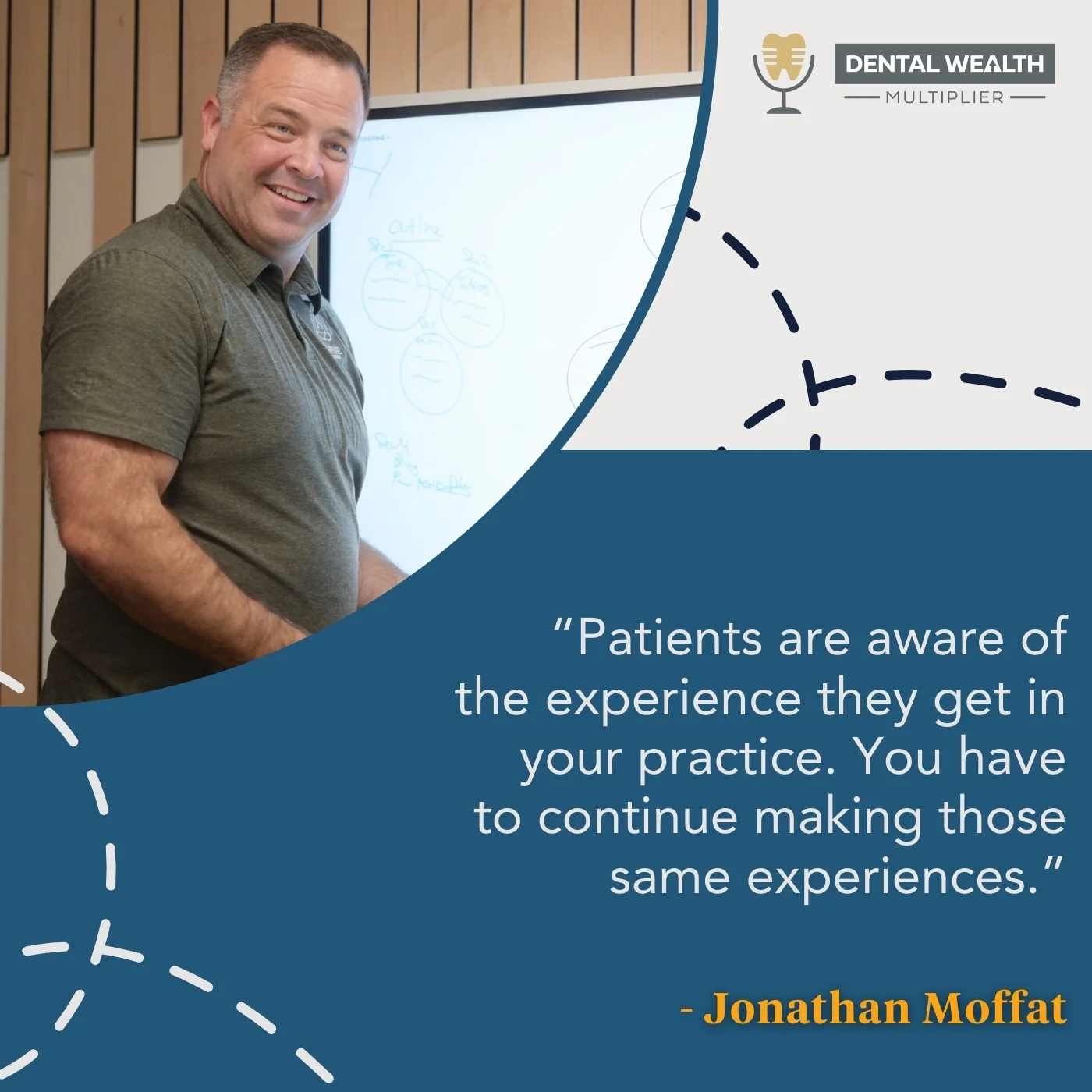
In this second part of their conversation, Jonathan Moffat and Melinda Heryford dig deep into what it really takes to make the associate relationship work long-term. They share best practices for onboarding, mentoring, and integrating new doctors into your culture. They also explore why so many associate relationships fail (and how to avoid that trap). From calibration systems and communication scripts to team-wide alignment, this episode is packed with practical takeaways for building a practice that runs without you, not in spite of you.
Melinda also offers a free Revenue Reveal for listeners: a data-driven exam that uncovers growth opportunities across 37 core practice metrics.
Find Jonathan at jonathanmoffat.com
Learn more about Aligned Advisors at alignedadvisors.com
Connect with Melinda at https://practicemanagementconsulting.com/
Find Jonathan on LinkedIn: linkedin.com/in/jonathanmoffat1
Find Melinda on LinkedIn: https://www.linkedin.com/in/melindaheryford/
Weekly episodes. Real strategies. No fluff.
Get more at dentalwealthmultiplier.com
—
Watch the Episode here
Listen to the Podcast here
From Turnover To Teamwork: Building A Practice Associates Want To Stay In With Melinda Heryford
Best Practices To Support Associates
I want to dig into maybe a little bit more on the associate piece, because it’s beautiful, and it comes up all the time. What have you seen as best practices for a doctor bringing in an associate, on what they should be doing to support that associate or associates, so that they can be as successful as possible in that role? I think one of the worst things that you could do in your practice is bring on an associate number one before your practice is ready and can support them, and before you’re ready to train and support them, because you’re going to end up with these yo-yo associates.
You then hear from the patients, “Why is there a different doctor every time I come in here?” It doesn’t have to be that way. I know there are best practices to implement so that you have a higher probability and a higher chance of having that successful associate. What have you seen? What do you train? Do you talk to your clients about as it pertains to that specifically?
I do try to have some trap potential because it makes it easier to hire. Maybe there’s hygiene you can add. Maybe there are different things that you can add because that makes it easier to add an associate. Sometimes they don’t start with a schedule. How are you going to build their schedule? Sometimes we activate hygiene, and they’re doing hygiene for the first few weeks. It doesn’t go on very long, Jonathan. It’s a great way for them to get integrated, meet the team, get a rhythm, and diagnose some dentistry.
I want to talk about the things you shouldn’t do, too. I’ll save those because there are a lot of bad practices that you’ve seen. That’s the reason you’re asking the question. It’s great to have some trap potential. You want to start them with a schedule. I think that the easiest and fastest way is to start them in hygiene because then they meet the patients, and it’s easy. It’s not an uphill battle. Immediately when that associate starts, the general dentists are doing exams. They’re doing periodic exams because we have a natural feeder with that periodic exam, as you know. That’s a great place for the associate to meet the doctor.
I like it when we already know what we’re going to say, and the team introduces the doctor, and there are 2, 3, or 4 talking points. “What’s great about this person? Why did we hire him? Why did we bring him on?” We don’t want him to look like a rookie, even if they don’t have as much experience. It’s like we got to figure out what’s good about them. The whole team is trained on how to do that. From the phone to the introduction, the hygiene, and the restorative team. When each doctor is doing an exam, the doctors are calibrated on their exams.

I like it when the hygienists are already co-diagnosing. When the hygienists are already co-diagnosing, it is an easy thing to step into for that new doctor because the hygienist has set it up. Calibration, and the senior doctor is saying, “As soon as we can get this done, the sooner the better, either with Dr. Clark or me, whoever can see you sooner, whoever can see you first.” That simple line gets the patient going, “I’ll book,” instead of, “Would you like to book with Dr. Clark?” What are they going to say, Jonathan? “Would you like to book with Dr. Clark?”
“No. I’d rather see Dr. Smith.”
“Not so much.” We are opening up a yes for the patient. Communication is such a powerful thing, as you know. We can make this thing go well or not based on how the whole team produces what we call preheat. You’ve heard that word, preheats the visit with the associate that in the huddle, we’re going through where the openings are, so that when the patient gets to the front desk, there’s like, “I have this or this.” It’s not like, “What would you like? When would you like to be seen?”
Weekly, we’re going through, sitting down with the team. What are the opportunities? How is the associate doing? What are the opportunities? We also set up a quality control system so that when that new associate is doing dentistry, they’re taking x-rays, they’re taking pictures of the work that they’re doing and there’s a quality control piece happening, so that the senior doctor is checking that and making sure that we’re in good shape and we’re not going to have to redo a bunch of dentistry.
It’s perfect for the doctor. We have ten sets of FMXs and scans, and we have the new doctor diagnose those, and the senior doctor diagnoses those, and they go through them together. That’s our calibration method for diagnosis. It’s an automatic way to see whether there is any mentoring necessary or we need to acknowledge them, but we want that senior doctor to go, “I’m here with you. I got you. You’re part of this deal. Let’s go.”
You can see it’s very much ingrained into the daily flow, the points where we are setting up the associate for success. I’ve heard doctors say, “I hired them. It’s their job to go find patients. It’s their job to go find to fill their schedule.” I don’t believe that. I think it’s our job to hire that associate, nurture them, and build their schedule with them.
It’s funny because what do we always say? “We’re a team. We take a team approach.” On the other hand, you’re like, “That’s their job to fill it.” That’s not a team.
It is the doctor’s job not only to hire associates but also to nurture and build a schedule for them. Share on XIt’s so crazy. Isn’t it?
I can understand what they’re saying. You don’t want to have a doctor who just comes in, shows up at 9:00, and is like, “Where’s all my dentistry?” The core admin plays a part in helping keep the schedule full. The doctor has to do a good job of providing good treatment and having good chairs so that the patient wants to come back for hygiene. All the pieces have to be working together.
I love what you said. We talk about supporting our team members, whether it be your front office, your assistants, your hygienist, your treatment coordinator, or your associates, but what does truly supporting them mean? Maybe it means that we sit down with them and have a conversation with them around what they are successful at, where they are strong, what things they like doing and don’t like doing, and where they need help or more training, or where they want training?
As we’re doing that, we’re supporting them. The idea is that, and with the understanding too, by doing all those things, it’s going to keep the schedule full, as a default. It’s going to keep our providers full. It’s going to help patients keep their appointments that they set. There’s going to be a culture that we create within our team and our offices. That’s a big piece. This is the problem. It’s hard work.
It’s conversation by conversation.
It’s creating systems and processes, putting them in, training, retraining, reviewing, and re-reviewing. When you have that cadence in place, you want to shift to something you talked about earlier, but when you have that cadence in place and keep it, those are the systems and processes to support the outcomes that you want. I don’t think people talk about enough how hard it is. It’s hard work. It’s very hard work.
How Associates And Patients Respond To Well-Built Systems
It is. When offices have streamlined systems that they are committed to, it makes them very attractive to an associate because an associate knows the difference. They’re like, “This is cool. This is awesome.” It makes it attractive for team members, too. It’s the beauty of defining and having standards and systems.

Patients recognize it too. That’s the part of it. We were at dinner with some friends, and there’s a restaurant called Wahoo’s Fish Tacos. I don’t know if they have many. It’s one of my favorite restaurants. It’s a super casual, like fish taco place that’s down here. I’ve been going there for years. It’s one of my favorite places to eat. It’s super chill and super casual. I’m telling you this story because I’m letting you know that your patients are aware.
One of the systems that they had was that you would get a number with a little stand. You would sit and put it on your table. Number twelve or whatever. They would bring you your food, and they would set your food down, and then they would walk away, and they would leave the number on the table. That was a signal to everyone else in the restaurant. No one has checked on this guest yet to make sure everything is okay with their food. A few minutes later, someone would come, they would grab the number, and they’d say, “Melinda, is everything fine with your meal? Is there anything else I can get you?” That was the process. That’s beautiful.
That’s a process. That’s gorgeous.
The last dozen times I’ve eaten there, it has not happened. They didn’t train. What happened? I ate there with some friends. They put our plate down. They grabbed the number and walked away. No one came back to check on us. No one came in and said, “Is everything okay with your food? Can I get you anything? Did everything come out exactly how you wanted it to?” There are a lot of reasons why, but the point is that it stopped happening.
That’s a reminder to us as owners of businesses or practices that number one, patients are aware of the experience that they have in your practice, and the systems and processes that you create to continue to make sure that they have those same experiences. When those change, patients are also aware. When you see patients maybe not scheduling their next hygiene visit or not accepting treatment, there are a lot of reasons to look at. One of the things you may want to look at is, “Are we consistently executing our systems and processes on a consistent basis to provide the type of experience that we want our patients to have?”
It takes repetition, training, and review. You have to keep doing that. It was something I noticed last time I ate there. I’ve noticed it before, but last time, we ate there with some friends. I was telling them because he owns a nursing care facility, and we were talking about this. It’s hard work to create these types of offices that run well.
It is. It’s a higher level. I will say that to do it does take 150 minutes. It takes working on the practice, having some time to work on the practice with your team, to practice, and to check. Having some ways to say, “Is it working the way we intended, or did we drop something out?” You’re right. People notice, “Something has changed there. I don’t know what it is, but something has changed.”
When offices commit to streamlining their systems, they become more attractive to work with. Share on XGathering Feedback From Patients Regularly
It’s a good reminder because our clients and your clients know. They notice, and patients notice. You should also have a way of checking in with patients, too, on how their experience was. We did this here at Aligned Advisors. We end every client meeting and progress meeting with a conversation or question around “This is our goal. These are our objectives. Did we meet those goals and objectives during our time together?”
If we didn’t, our clients let us know. It was interesting. We had this conversation at a client meeting. I was sitting in a client meeting, and the client said, “I need to bring some stuff up. I need to bring something up here to you guys to bring to your attention.” It was good. The feedback they gave us was good. It helped me see that there’s a missing piece here. We have a system in place, but it’s not being executed.
Make sure you have some systems for your patients to give you that feedback that isn’t just a text message of, “Give us a five-star rating and review so people see how amazing we are.” That’s a good thing, but a process built in where you’re asking them face-to-face. Most people are pretty nice and professional. Unless something goes wrong, they’re not going to blow your practice up online, typically.
No, especially if you’re asking them every single time when you’re with them. How powerful is that? I love that process. I’m going to steal that process, Jonathan. I’m going to borrow that from you because that’s a good one. I love so many pieces of that. I love it that it’s real. It’s right now, in the moment we’re together. I could see dentists going, “That’s confrontational.” How beautiful. If your patients start to rely on that, just like your clients rely on that, it’s a way to keep your communication, your relationship, and the loyalty. It’s so powerful. I love that system.
Setting A Clear Vision And Mission
Often, we do these, “Do you have a vision? Do you have a mission?” It’s just a box we’re checking. It’s like, “We got a mission. We got a vision.” When I’m speaking, I always ask, “Does any of you have any team members in the room?” If you dare raise your hand, “Stand up and recite your mission and vision.” Most of them cannot. Even if they could, “What’s your vision or your mission?” “Our mission is to treat our patients, give our patients the best hygiene care, to create healthy mouths within our community.” It’s somewhere around there. I’ve read enough to know what that’s going to be.
“Okay, great. How do we support that mission and vision on a daily basis?” In my opinion, one of the ways to do that is to say, “Melinda, thanks so much for coming into the office. As you know, our mission as an office in our community is to make sure that all of our patients leave feeling healthier about their mouth than they did when they came in today. Did we accomplish that?”
I want the doctors to write this down. That is freaking beautiful. It’s beautiful. “Did we do it for you?”
It’s reinforcing the mission to your team. It’s reinforcing your vision to your patients. Throughout my life, not recently, thankfully, but I have gone to the big commercial dental practices where you come in, you’re a number, you’re done, pay at the back, whatever. As much as we like to think, especially on the private practice side, that we’re different, we treat patients better, maybe you think you do, but your patients aren’t experiencing it.
People would love to work for as long as they could if they were given a little freedom. Share on XIt’s such a good point.
What are you doing in your practice to make sure that the patient leaves going, “I’m glad I’m going to doctor so and so, and not XYZ dental with 300 locations and whatever.” As you were talking about something that I had thought about, it all goes back to the systems and processes. You’re talking about those six metrics that you measure, making sure that the whole team is on board. Making sure it’s owner-doctor supported. It’s hard to be an absentee owner. It’s not impossible. I think absentee owner is different because there are different layers of what that could mean. I don’t even like that name, absentee owner, because it has a negative connotation.
It’s the name first.
Correct. You don’t care that you’re absent. That’s not the doctors that you and I are working with. That’s not what they want. They do care. It’s just that they’re saying “My time is better used not chair-side, doing other work in other aspects of the business.” That means you have to be engaged. You have to continue to be engaged in the business.
You do. The caveat to that is that there’s still an absolute leadership presence leading that team, even when you have a leadership team, even when you have awesome systems. It can operate without you being there. I think it’s a great goal that it can operate without you being there, and that the culture also wants to hear from you. The culture, the team wants to hear from you. It is that delicate balance. A lot of my clients, probably you too, would work as long as they could because they truly love what they’re doing. They just want a little freedom. There’s a little freedom, lots of time off.
It’s possible. The client I talked to as we were starting this, I think I introduced you to him. He has two practices in Sacramento. He just got back from two weeks in Europe, and he was saying what a great refresher it was. He goes on a trip once a quarter for a couple of weeks somewhere. It is possible.
I have a client who takes a week a month, and he’s been practicing for over twenty years, but she’s been doing that for a long time. Our goal for each client is that for a minimum of 8 to 12 weeks a year, everything else can hum and they get some good time off.

All About The Revenue Reveal
I love that. Melinda, thank you so much for coming on here. This has been awesome. You’ve dropped some amazing gems of wisdom. Is there anything else you want to share or any parting words of wisdom you want to give before we come to an end here?
There are several things that we talked about that can make life easier. I would love to take advantage of those. We have something called Revenue Reveal, which is an exam for the practice, but it pops what opportunities they are. It’s great. There are 37 metrics that we look at in comparison to the industry. It’s about getting patients, keeping patients, caring for patients, and collecting. Those are the four categories that we look at. It’s a great package for what’s possible for the practice.
It’s a great conversation opener for a doctor to say what they want, where they’re headed, what that looks like, how their current practice could support that, and what that would look like. I’ll give you that information, and they can contact us if that’s something that they want to take advantage of. That’s our gift. It’s usually $1,000, and it’s our gift to your audience to support them.
Get In Touch With Melinda
Thank you for that, Melinda. That’s awesome. If people want to look you up on LinkedIn or Instagram, how do they do that?
It’s my name, Heryford, and it’s PracticeManagementConsulting.com. It’s super easy. We’re consultants.
Melinda, thanks so much for coming on here. It was so much fun. Every time we got together and talked, I always felt like some great energy and great ideas were being thrown back and forth. I appreciate you coming on and sharing your years of expertise and experience with us. I appreciate you and all that you’re doing to serve our community.
Thank you, Jonathan. Likewise. It’s so much fun to be with you.
Thanks, everyone. Go ahead and look for that link. Until next time, keep going. Thanks.
Important Links
- Melinda Heryford on LinkedIn
- Melinda Heryford on Instagram
- Practice Management Consulting
- Jonathan Moffat
- Jonathan Moffat on LinkedIn
- Aligned Advisors
- From Pain to Plan – The CEO Vision Day
About Melinda Heryford
 Melinda Heryford is a visionary change-maker, strategic guide, and influential voice in the world of dental practice transformation. With over four decades of experience coaching high-performing teams and private practice owners, she is the creator of the Prime Journey Process™, a structured yet flexible roadmap that transforms chaos into clarity, underperformance into profitability, and staff turnover into team synergy.
Melinda Heryford is a visionary change-maker, strategic guide, and influential voice in the world of dental practice transformation. With over four decades of experience coaching high-performing teams and private practice owners, she is the creator of the Prime Journey Process™, a structured yet flexible roadmap that transforms chaos into clarity, underperformance into profitability, and staff turnover into team synergy.
Melinda Heryford helps dental practice owners and teams get clear, focused, and wildly successful. She’s the creator of the Prime Journey Process, a system that turns confusion into clear steps—and helps teams work better together, increase profits, and serve patients with excellence.
Melinda is known for bringing energy, direction, and heart into every room. She’s a coach, speaker, and trainer who gets results fast—by helping people do what they do best. She sees the potential in others and lights a fire under it.
